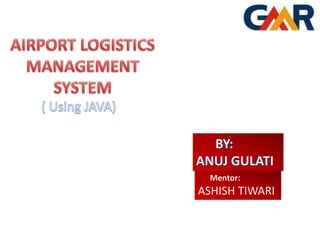
GMR PROJECT PPT
- 2. Working at GMR Understanding and building of design and GUI of applications based on client needs. Analyzing and troubleshooting of design related problems. Creating design replica of GMR’S logistics management system application(presently being used).
- 3. History Java is a programming language created by James Gosling from Sun Microsystems in 1991. The first publicly available version of Java (Java 1.0) was released in 1995. Over time new enhanced versions of Java have been released. The current version of Java is Java 1.7 which is also known as Java 7. From the Java programming language the Java platform evolved. The Java platform allows software developers to write program code in other languages than the Java programming language and still runs on the Java virtual machine. The Java platform is usually associated with the Java virtual machine and the Java core libraries. Introduction to JAVA
- 4. Java Virtual machine The Java virtual machine (JVM) is a software implementation of a computer that executes programs like a real machine. The Java virtual machine is written specifically for a specific operating system, e.g. for Linux a special implementation is required as well as for Windows. Java programs are compiled by the Java compiler into bytecode. The Java virtual machine interprets this bytecode and executes the Java program. Development Process with Java Java source files are written as plain text documents. The programmer typically writes Java source code in an Integrated Development Environment (IDE) for programming. An IDE supports the programmer in the task of writing code, e.g. it provides auto-formating of the source code, highlighting of the important keywords, etc. At some point the programmer (or the IDE) calls the Java compiler (javac). The Java compiler creates the bytecode instructions. These instructions are stored in .class files and can be executed by the Java Virtual Machine.
- 5. ->The target of Java is to write a program once and then run this program on multiple operating systems. Java has the following properties: Platform independent: Java programs use the Java virtual machine as abstraction and do not access the operating system directly. This makes Java programs highly portable. A Java program (which is standard complaint and follows certain rules) can run unmodified on all supported platforms, e.g. Windows or Linux. Object-orientated programming language: Except the primitive data types, all elements in Java are objects. Strongly-typed programming language: Java is strongly-typed, e.g. the types of the used variables must be pre-defined and conversion to other objects is relatively strict, e.g. must be done in most cases by the programmer. Interpreted and compiled language: Java source code is transferred into the bytecode format which does not depend on the target platform. These bytecode instructions will be interpreted by the Java Virtual machine (JVM). The JVM contains a so called Hotspot-Compiler which translates performance critical bytecode instructions into native code instructions. Automatic memory management: Java manages the memory allocation and de-allocation for creating new objects. The program does not have direct access to the memory. The so-called garbage collector deletes automatically objects to which no active pointer exists. The Java syntax is similar to C++. Java is case sensitive, e.g. variables called myValue and myvalueare treated as different variables. Benefits of JAVA
- 6. Use of JDBC/ODBC SQL is as a backend in our JAVA application . It stores all the values ( text , number , pictures etc) that are either inserted by the user or are needed during the execution of the application. I t can be stated as virtual memory for for JAVA applications.
- 7. About The Project !!!! It has been developed to offer Logistics handling at airports to remove many of their current manual process. What this means for the shipper is that they can now have at their fingertips a “supply chain management system” that delivers information faster than the traditional methods. This information is extracted from as close to the source of the information as possible. To develop an ERP short for Enterprise Resource Planning, a business management system that integrates all facets of the business, including planning, ordering and sales etc. As the ERP methodology has become more popular, software applications have emerged to help business managers implement ERP in business activities such as stock control, order tracking and customer service. Enterprise Resource Planning: ERP is a software solution that addresses the enterprise needs taking the process view of an organization to meet the organizational goals tightly integrating all functions of an enterprise. It facilitates company wide integrated information system covering all functional areas. ERP performs core corporate activities and increase customer service augmenting corporate image. It integrates the following one Database. Application. Tools.
- 8. Objectives Of Logistics Supply Management System Modular structure. Online system. More flexibility. Extensive data handling capacity. Expandable. Fastest possible printing. Flexible Report. Proven Performance. Cost Effective. Security. Graphical User Interface. Uses most powerful & widely used RDBMS.
- 17. CONCLUSION In the past, the employees of the Warehouse have been associated with performing organizational function, such as order tracking, stock maintenance and products category management in accordance with policies that have been established in conjunction with organization. The project deals with various operations and transactions that are carried out in the different levels of Logistics Supply Management System. Waterfall model is adopted for the development of the project The developed system is user friendly and the changes can be made easily as and when required. Hence the system can be maintained successfully without much rework. The Logistics supply management System thus developed provides highly coordinated and collaborative means for managing the sales and inventory activities in the organization. It serves, as a gateway for the accurate tracking of customer needs. It helps to track the project execution between the organizations. The features incorporated in the system such as Big Database Maintenance. Order Management. Customers Rating.
- 18. THANK YOU FOR WATCHING